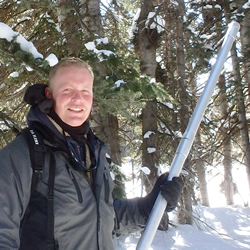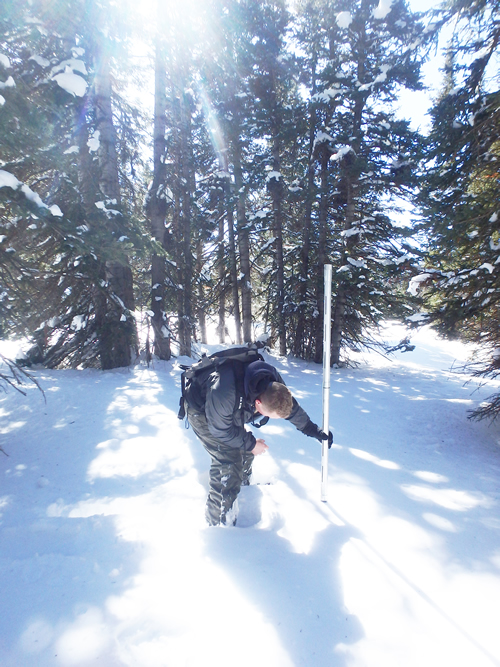News Article
January 26, 2016
Where Does the Water From Snow Actually Go?

Each winter, as the snow falls across Utah, hope grows that the accumulating snowpack will ease our drought conditions, and supply the state with water throughout the year. While snowfall can happen anywhere in the state, it accumulates most in the mountains, where elevation, aspect, and vegetation cover vary greatly. Natural disturbances such as fires and insects further alter the landscape, and change the way the snow accumulates and contributes to our watershed.
These are subjects that interest Jordan Maxwell, graduate research assistant and PhD student at Brigham Young University. Now into his second year of his research, Jordan is working with faculty advisor Dr. Sam St. Clair to measuring snowpack across gradients of disturbance in Utah’s alpine regions.
For Jordan, a good snowfall gives him the opportunity to ski into remote regions of Utah where he takes snow measurements. While this may sound like a Herculean task, he is especially interested in focusing on areas where the vegetation cover has been disturbed or eliminated by insects or fire to see if these changing conditions influence snow accumulation and water retention. One of the questions he wants to answer through his research is-- how do disturbances such as fire and/or tree deaths due to beetle attacks affect how much water will be available to come through our faucets?
Preliminary research conducted during Jordan’s first year examined areas of Twichell Canyon in central Utah, and selected Snow Telemetry (SNOTEL) sites, as well as other areas burned by the 2010 Twitchell Canyon fire. SNOTEL, operated by the U.S. Department of Agriculture’s Natural Resources Conservation Service (NRCS), is an automated system, with over 600 sites across 13 states, which measures snowpack and related climate sensors. His findings for this initial research confirmed that there was an inverse relationship between vegetation, density of tree cover, and snow accumulation.
Continuing research conducted this winter will be more robust, covering a larger collection area and a change in location patterns to generate a more random sampling. First, sections of forests are identified by type of forest, along with four categories of fire severity disturbances, including intact, open, moderate, and severely burned. Samples measure for snow water equivalence (SWE), how much water there is in the snow, and snow depth. These measurements will help in developing a GIS snow-water equivalence model to discover how much water is in a watershed, and what changes occur after a disturbance such as fire. Future and follow-up research will look at snow ablation.
Also Jordan will compare the data he is collecting to the SNOTEL data to see how vegetation is affecting snow accumulation. He hopes that his research will provide other researchers working with NRCS, including water and fire managers, a model for predicting how snowfall in an area, and thus usable water, may be altered by changes in vegetation.
By combining research results and data collection into a model that can be used for predictions, Jordan hopes to help researchers predict how much the snowpack is contributing to the watershed in Utah, as well as contribute to helping properly manage and protect it. He will use his findings in two manuscripts summarizing the results of research and data collections, one on SNOTEL, and the other on snow in the post fire conditions of Twitchell Canyon.
When describing his lab at BYU, Jordan says that while research topics range from invasive plant management in sagebrush deserts to grazing patterns of mammals, everyone is interested in the same question: How much water do we have this year? He says that “water is a central point in all their research, it affects everyone.”

Jordan Maxwell, PhD student at Brigham Young University taking snow measurements. Credit: J. Maxwell
« Back to list of all news articles


